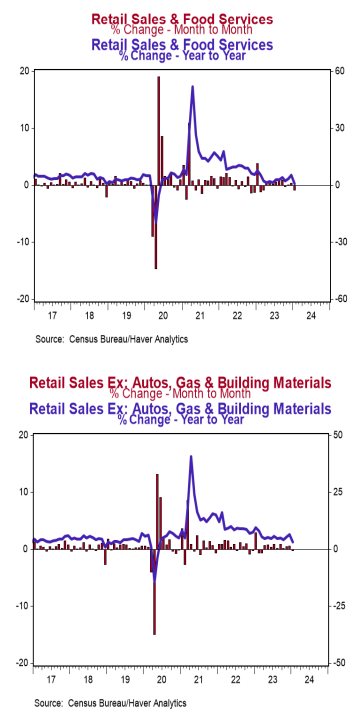- Retail sales declined 0.8% in January (-1.4% including revisions to prior months), lagging the consensus expected decline of 0.2%. Retail sales are up 0.6% versus a year ago.
- Sales excluding autos dropped 0.6% in January (-1.0% including revisions to prior months), lagging the consensus expected gain of 0.2%. These sales are up 1.2% in the past year.
- The largest declines in January were for autos, building materials, and non-store retailers.
- Sales excluding autos, building materials, and gas declined 0.2% in January and were down 0.6% including revisions to prior months. If unchanged in February/March, these sales will be up at a 1.0% annual rate in Q1 versus the Q4 average.
Implications: An ugly report on the US consumer today with retail sales declining 0.8% in January, lagging consensus expectations, with nine out of thirteen major categories falling for the month. Factoring in revisions to prior months, retail sales fell an even larger 1.4%. The drop in sales in January was led by the volatile auto sector (-1.7%), but stripping this category out does not improve the picture. Sales excluding autos fell -0.6% and were down an even faster 1.0% when factoring in revisions to prior months. Other categories to lead the decline in January were building materials (-4.1%) and non-store retailers (-0.8%). Overall retail sales are up a meager 0.6% in the last year, although that’s also due to a surge in sales in January 2023 that temporarily makes a tough comparison point for the year ago comparison. Still, it appears consumers are finally running out of excess COVID savings, which were boosted by temporary and artificial government stimulus payments in 2020-21. Retail sales have fallen in three of the past four months. While recent data suggest the goods side of the economy may already be in recession, the same cannot be said for the services side. Sales at restaurants & bars – the only glimpse we get at services in the retail sales report – rose 0.7% in January. These sales are still up 6.3% in the last twelve months and have yet to show signs of slowing; up at 9.5% and 10.1% annualized rates on three- and six-month timeframes, respectively. But it’s important to remember that one of the key drivers of overall spending is inflation. Yes, retail sales are still hovering near record highs unadjusted for inflation, but in “real” (inflation-adjusted) terms, they have been stagnant for nearly two years. Real retail sales peaked back in April 2022 and have since declined by 3.4% from that peak. In the last twelve months, real retail sales are down 2.4%. Our view remains that the tightening in monetary policy since last year will eventually deliver a recession. Expect more deterioration in real retail sales into 2024 as tighter credit conditions along with higher borrowing costs take their toll. In employment news this morning, initial claims for jobless benefits declined by 8,000 last week to 212,000, while continuing claims rose by 30,000 to 1.895 million. These figures suggest continued job growth in February. In other news this morning, trade prices jumped in January, as import and export prices both rose 0.8%. In the past year, import prices are still down 1.3% while export prices are down 2.4%.





